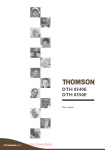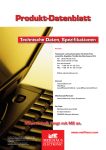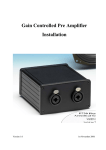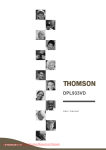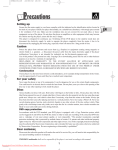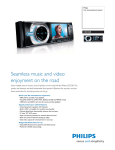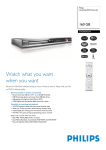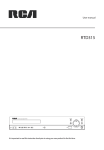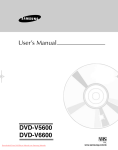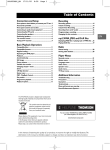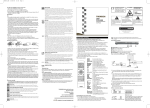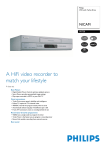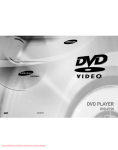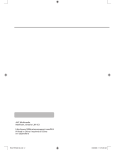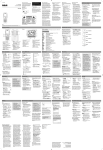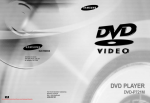Download Thomson DTH6000 User Guide Manual - DVDPlayer
Transcript
Contents Installation DVD Mode Precautions and guarantee . . . . . . . . . .2 Box contents . . . . . . . . . . . . . . . . . . . .3 Connections . . . . . . . . . . . . . . . . . . . . .4 Play Basic connection - Other connection possibilities Other devices . . . . . . . . . . . . . . . . . . . .5 Remote control . . . . . . . . . . . . . . . . . .6 . . . . . . . . . . . . . . . . . . . . . . . . . .22 Simple play - Accelerated play - Still image / Frame advance - Variable slow motion - Zoom function Play Modes . . . . . . . . . . . . . . . . . . . . .23 Standard play - Random play - Program play - Edit program - Autoplay - IntroScan General functions - Functions in DVD mode Functions in VCR mode Lock . . . . . . . . . . . . . . . . . . . . . . . . . .24 Front panel controls . . . . . . . . . . . . . . .8 Front panel display . . . . . . . . . . . . . . . .9 Initial installation . . . . . . . . . . . . . . . .10 Display . . . . . . . . . . . . . . . . . . . . . . . .25 Modulator - Automatic channel search - Clock setting - Sorting the channels - New or encoded channel Menus . . . . . . . . . . . . . . . . . . . . . . . . .13 VCR menus - DVD menus - Disc content menus PlayBack Control (PBC) menus VCR Mode EN Lock Player - Unlock Player - Change Password Ratings limits - System Test TV Image - On-Screen Displays Sound . . . . . . . . . . . . . . . . . . . . . . . . .26 Sound Logic - Digital Output Languages . . . . . . . . . . . . . . . . . . . . . .27 Player Menus - Disc Menus - Audio - Subtitles Info Menus . . . . . . . . . . . . . . . . . . . . . 28 Direct access - Repeat playback - Markers - Audio - Subtitles - Camera angles - Playback mode IntroScan - Audio channel Reading MP3 files . . . . . . . . . . . . . . . .30 Playing a tape . . . . . . . . . . . . . . . . . . .14 Inserting a tape - Playing a tape - Continuous play Accelerated play - Still image / Pause - Variable slow motion - Rewind or Fast forward - Stop / Ejecting the tape What is MP3? - Playing an MP3 CD - Skipping songs Discs you can play . . . . . . . . . . . . . . . .31 Troubleshooting . . . . . . . . . . . . . . . . .32 Technical data . . . . . . . . . . . . . . . . . . .33 Recording . . . . . . . . . . . . . . . . . . . . . .15 Getting prepared - Simple recording - Recording with automatic stop (instant record) - Continuous recording Programming a recording . . . . . . . . . . .16 Programming using a PlusCode® number Storage of the programme numbers with the VIDEO Plus+® feature - VIDEO Plus+ system and satellite demodulator - Without the PlusCode programming numbers - To check your programming - Error messages likely to occur when programming - Deleting a programmed recording - Recording programmed on a connected set Sound control . . . . . . . . . . . . . . . . . .19 Sound selection in playback mode - Setting the type of sound to be recorded DVD copy protection In accordance with the DVD standard, your DVD player is equipped with a Copy Protection system, which can be triggered on and off by the DVD disc itself, in order to make any recording of the concerned DVD disc onto a videotape of very poor picture quality, or even impossible. “This product incorporates copyright protection technology that is protected by method claims of certain U.S. patents and other intellectual property rights owned by Macrovision Corporation and other rights owners. Use of this copyright protection technology must be authorized by Macrovision Corporation, and is intended for home use only unless otherwise authorized by Macrovision Corporation. Reverse engineering or disassembly is prohibited.” Preferences . . . . . . . . . . . . . . . . . . . . .20 Eco mode - Auto clock - VIDEO Plus+ + 10 Other functions . . . . . . . . . . . . . . . . . .21 Index search - STATUS menu - Tracking and stability in play mode - Playing NTSC tapes Downloaded From DvDPlayer-Manual.com Thomson Manuals 1 Precautions and guarantee SETTING UP - Ensure that the mains supply in your house complies with that indicated on the identification sticker located on the back of your appliance. Install your appliance horizontally, away from any source of heat (fireplace) or appliances creating strong magnetic or electric fields. The components of this appliance are sensitive to heat. The maximum ambient temperature should not exceed 35° Celsius. Leave sufficient space around the appliance to allow adequate ventilation: 10 cm on either side and at the rear, as well as 7 cm above the top are minimum requirements. The humidity of the room should not exceed 80%. If you have to use the appliance outdoors, do not expose it to water from rain or splashing. Moving it from a cold atmosphere into a warm one is likely to cause condensation on some components inside the appliance. Let the condensation disappear by itself before turning the appliance on again. 7 cm 10 cm 7 cm 10 cm 10 cm USE - If your appliance has been stored in a cool place for any length of time, during a journey for example, wait for about 2 hours before using it. The openings located on the top and bottom are for ventilation and must not be obstructed. During thunderstorms, we recommend that you isolate the appliance from the electrical supply and the aerial so that it is not damaged by electrical or electromagnetic surges. To completely isolate the equipment, remove the plug from the mains socket as some components remain connected to the electrical supply. If you notice any burning or smoke, disconnect the appliance immediately to avoid all risk of electrocution. Do not attempt to look inside the appliance, through the opening of the disk tray or any other opening. You may be electrocuted or be exposed to laser radiation. This unit is for domestic use only and must not be used for industrial purposes. Total or partial copying of recordings protected by copyright legislation, without the explicit permission of the holder of the rights, contravenes current legislation. Copying or downloading music files for sale or any other business purpose constitutes or could constitute a violation of copyright law. CLEANING – Use a soft, dry and clean cloth. Regularly dust the vents at the back or sides. Using solvents, abrasive or alcohol based products risks damaging the set. If an object or liquid enters inside the appliance, unplug it immediately and have it checked by an authorised technician. To avoid deterioration of your appliance’s heads, never use a cleaning tape. GUARANTEE - The type and production number of your appliance are printed on the guarantee certificate delivered with your appliance. Keep this certificate as well as the invoice. These documents are indispensable for claiming your guarantee rights. All repairs during the guarantee period must be carried out by an authorised technician representing our brand. If this condition is not met, your rights will no longer be valid. Never open the appliance yourself, since this may be dangerous for you or damage the equipment. Thomson multimedia is not liable if the appliance is used other than in accordance with this manual. DISCLAIMER OF WARRANTY: TO THE EXTENT ALLOWED BY APPLICABLE LAW. REPRESENTATIONS AND WARRANTIES OF NON-INFRINGEMENT OF COPYRIGHTS OR OTHER INTELLECTUAL PROPERTY RIGHTS RESULTING FROM THE USE OF THE PRODUCT UNDER CONDITIONS OTHER THAN AS HEREABOVE SPECIFIED ARE HEREBY EXCLUDED. 2 Downloaded From DvDPlayer-Manual.com Thomson Manuals Set-up Box contents Thank you for purchasing one of our videos. Unpack the set completely and tear off the protection films. D V D / V I D E O C D / C D / M P 3 P L AY E R / V I D E O C A S S E T T E R E C O R D E R D T H 6 0 0 0 EN HIFI STEREO NICAM DVD-VCR DVD/VCR VIDEO L AUDIO REC CHANNEL EJECT PLAY/PAUSE STOP REV FFW OPEN/CLOSE R NTSC PLAYBACK PAL Remote control PR Coaxial cable (75 Ω) Euro Scart cable 0%MERCURY SIZE AA 1,5 V EXTRA HEAVY DUTY GREENE LL GR EE EX TR A HE NE L SIZ AV E AA Y DU L 1,5 V TY + - - + 2 non-rechargeable batteries, type AA 0%ME RCUR Y 1 2 3 Do not mix different types of batteries or new and old batteries. Do not use rechargeable batteries. In order to avoid any risk of explosion, observe polarities indicated inside the battery compartment. Replace only with the type of batteries specified above. Do not throw them into fire, do not recharge them. If you are not using the remote control for a long period of time, remove the batteries. Please respect the environment and prevailing regulations. Before you dispose of batteries or accumulators, ask your dealer whether they are subject to special recycling and if they will accept them for disposal. 0 600 DTH Set-up and user manual al manu User To respect the environment, we have printed this document on unbleached recycling paper. Downloaded From DvDPlayer-Manual.com Thomson Manuals 3 Set-up Connections Basic connection IN AV1 EURO AV2/DECODER ANT. IN AUDIO OUT VIDEO OUT DIGITAL AUDIO OUT COAXIAL R ANT. OUT OPTICAL L EURO AV1 AV1 OUT 220V/240V - 50Hz Coaxial cable supplied EXT1 AUX1 Scart Cable supplied 1 Disconnect the aerial cable from your TV set and reconnect it to the IN socket of 2 3 4 the DVD/VCR. Using the coaxial cable (supplied), connect the OUT socket of the DVD/VCR to the aerial socket g of the TV. A SCART cable (supplied) connection between the appliance and your TV makes it easier to use and improves picture and sound quality. Connect the AV1 (audio/video 1) socket of the DVD/VCR to the SCART socket of the TV (AV1, EXT1, AUX1 depending on make). Using the mains lead, connect the appliance to a mains socket. Other connection possibilities The connections described above are for standard quality sound and high quality picture reproduction. If your TV set does not have a SCART socket, connect the DVD/VCR to your TV in one of the following two ways. Video connection Connect the VIDEO OUT socket of the DVD/VCR to the VIDEO IN socket of the TV set using a video cable (not supplied). Audio connection To obtain 6-channel multichannel sound, connect the TV set to the DIGITAL AUDIO OUT coaxial socket of the DVD/VCR using a coaxial cable (not supplied), or to the DIGITAL AUDIO OUT optical socket of the DVD/VCR using an optical cable (not supplied). Alternatively, you can connect the AUDIO OUT L and R sockets of the DVD/VCR to the AUDIO IN L and R sockets of the TV using an audio cable (not supplied). 4 Downloaded From DvDPlayer-Manual.com Thomson Manuals Set-up Other devices Decoder, camcorder, satellite receiver, another DVD player, another video recorder, etc. (AV2 socket) EN Connect another device to the AV2 socket of the DVD/VCR using the SCART cable (supplied). The pictures from the other device go through the AV1 socket of the DVD/VCR and then on to the TV set. Camcorder (AV3 socket) Connect your camcorder to the AUDIO L (left), AUDIO R (right) and VIDEO sockets located at the front of the DVD/VCR. Select the AV3 input on the DVD/VCR by pressing the AV key. VIDEO L AUDIO R Audio/video amplifier Video connection Connect your audio/video amplifier to the AV1 SCART socket of the DVD/VCR. You can also connect it to the VIDEO OUT socket of the DVD/VCR with a video cable (not supplied). You will get the best picture quality with the SCART socket. Audio connection For 6-channel multichannel sound, connect the amplifier to the DIGITAL AUDIO OUT coaxial socket of the DVD/VCR using a coaxial cable (not supplied), or to the DIGITAL AUDIO OUT optical socket of the DVD/VCR using an optical cable (not supplied). You can also connect your audio/video amplifier to the AUDIO OUT L and R sockets of the DVD/VCR using an audio cable (not supplied). You will get the best sound quality with a connection via the DIGITAL AUDIO OUT socket. Stereo HiFi system Connect your HiFi system to the DIGITAL AUDIO OUT socket of the DVD/VCR, or to the DIGITAL AUDIO OUT optical socket of the DVD/VCR, or to the AUDIO OUT L and R sockets of the DVD/VCR. Downloaded From DvDPlayer-Manual.com Thomson Manuals 5 Set-up Remote control General functions Switch the appliance on or off. Switch the appliance on and change to DVD mode. Switch the appliance on and change to VCR mode. Navigate through the menus. Increase the volume. PR Mute and restore the sound. Number entry. Confirm a selection in a menu. Start playing a disc or a tape. Stop play, accelerated search, slow motion or recording. Start fast reverse, reverse accelerated play or reverse slow motion (see pages 14 and 22). Start fast forward, forward accelerated play or forward slow motion (see pages 14 and 22). Freeze frame or frame advance (see pages 14 and 22). 6 Downloaded From DvDPlayer-Manual.com Thomson Manuals Set-up Functions in DVD mode Functions in VCR mode Return to the previous menu on an interactive disc or hide the info menu. Exit a menu. Access the audio function of the info menu (see page 29). EN Access the subtitle function of the info menu (see page 29). Access the info menu (see page 28). Access the page 15). STATUS menu (see OVERVIEW main menu. Access the contents menu of the disc. Access the camera angle function (see page 29). Access the disc menu during play (if there is one) or resume play. Access the Directly access the next (pr+) or previous (pr-) chapter (DVD) or track (CD). Change channel on the video recorder Drop down the VIDEO Plus+ menu. Return directly to the main menu or hide the info menu. Set the counter to zero, cancel a programme or return to the standard set-up. Access the Zoom function (see page 22). Double the recording time of a cassette with the LP function. Move backward 10 seconds during disc playback. Select the devices connected to the Audio/Video sockets (AV1, AV2, AV3, DVD). Start recording. Select a channel. For 2-digit channels, first press 0/-- (0, 1, 2 for Pr12). Downloaded From DvDPlayer-Manual.com Thomson Manuals 7 Set-up Front panel controls The appliance has some of the remote control functions on its front panel. 2 3 4 1 5 DVD / VIDEO CD / CD / MP3 PLAYER / VIDEO CASSETTE RECORDER DTH 6000 HIFI STEREO NICAM DVD/VCR VIDEO L AUDIO REC CHANNEL EJECT PLAY/PAUSE STOP REV FFW OPEN/CLOSE R NTSC PLAYBACK PAL 6 7 89 Ref. on the diagram 8 Function 1 Switch the appliance on and off. 2 Switch the appliance on, and change from DVD mode to VCR mode and vice versa. 3 Start recording in VCR mode. 4 Start a fast forward or reverse search for a chapter, track or index in DVD mode; change channel in VCR mode. 5 Eject the cassette from the video recorder. 6 Start playing a disc (DVD mode) or a tape (VCR mode) or go into pause. 7 Stop playback of a disc (DVD mode) or a tape (VCR mode). 8 Fast reverse. 9 Fast forward. 0 Open and close the disc tray of the DVD player. Downloaded From DvDPlayer-Manual.com Thomson Manuals 0 Remote control key Set-up Front panel display EN VCR COPY VCR Digital Hi-Fi SVC DVD 3D APM T dts SLP C MUTE MP3 ONE ALL A-B DVD Appears when the appliance is in VCR mode. Appears when a tape is inserted in the video recorder. Indicates that a recording is programmed or in progress. Hi-Fi SLP Appears when the sound of a recorded cassette or one being recorded is high fidelity. Indicates the tape recording speed (SP, LP or SLP). Appears when the appliance is locked. T C Digital Indicates the title or track being played. Indicates the chapter being played. Appears when the sound is Dolby Digital. dts Appears when the sound is in DTS. MP3 Appears when an MP3 disc is loaded. SVC DVD Indicates the type of disc loaded: DVD, CD (Audio CD), VCD (Video CD). ONE Indicates the repeat playback of a chapter or a track. ALL Indicates the repeat playback of the entire disc. Indicates the repeat playback of a sequence (see page 28). A-B DVD Appears when the appliance is in DVD mode. Appears when a disc is loaded. The speed and direction show the play mode of the disc. Downloaded From DvDPlayer-Manual.com Thomson Manuals 9 Set-up Initial Installation Modulator If you haven't used a SCART cable (supplied) to connect your TV to the AV1 socket of the DVD/VCR, then proceed with the settings below before you go to channel set-up. If you have used a SCART cable, go directly to the Automatic channel search section. 1 Switch the DVD-VCR ON by pressing the B key on its front panel. 2 Press the VCR key on the remote control. 3 Hold down the MENU key on the remote control until SY4 comes up on the video 4 5 recorder display. Validate your choice using the OK key. Please wait: the video recorder is searching for a channel within the range 21 to 69, available for transmitting pictures to the television via the coaxial cable. After a while, the video recorder display indicates the channel that will be used for this purpose. Note down the number here . Switch ON your television set. Take the user manual of your television and carry out the steps below. 6 Select an available channel number (a channel which has no picture). 7 Follow the instructions of your television user manual to find the video channel of the video recorder (the one you noted down above). Once the television has found the video channel of the video recorder, the following message will be displayed on the screen (VCR, C CH 52 B). If the picture is poor (snowy, torn), change the communication channel of the video recorder with the C / B keys. 8 Store the channel and its number on the television set. From now on, to watch the video recorder pictures or menus, select the channel assigned to the video recorder on your TV set, i.e. the channel number chosen in step 6. 9 Continue with Automatic channel search. Automatic channel search The appliance has not been programmed to receive the channels in your area. Follow the automatic set-up procedure below to set up the channels. 1 Switch the DVD-VCR ON by pressing the B key on its front panel. 2 Press the OK key. This video recorder comes with the NexTView Link feature. This function simplifies the channel set-up procedure, as the channels already set up on a TV set fitted with the NexTView Link or similar feature (Easy Link, Smart Link, Megalogic, etc.) can be downloaded to the video recorder. The channels downloaded this way to the video recorder keep the same properties as on your TV set (same number, same name, etc.). 10 Downloaded From DvDPlayer-Manual.com Thomson Manuals Set-up If your TV set is fitted with the NexTView Link function or similar, the video recorder automatically initiates channel download once you have selected the country. You can view channel download on the video recorder display (Pr1, Pr2, Pr3…). On completion of download, the video recorder switches over to standby. Channel set-up is achieved. When your television set is not fitted with the NexTView Link or any similar feature, a message tells you that your video recorder is searching and storing the channels you can receive in your region. Keep patient until a message informs you that your channels are stored. DOWNLOAD COMPLETED EN AUTO INSTALL COMPLETED EXIT Leave B Organiser Clock setting 3a If date and time are correct, press EXIT to leave the menus. 3b If the displayed time is incorrect or was not transmitted, set the clock with the number keys 0 to 9: enter time and date in the following order: hour, minute, day, month, year. 4 Store with OK. 5 Quit with EXIT. Time --:-- Day -- 0-9 Month -- Year 20-- OK VCR Sorting the channels The automatic channel set-up assigns the numbers to the channels in a predefined order. These numbers may therefore not match the actual channel numbers. Should this be the case, change these numbers by carrying out the instructions below. For easy channel identification, we suggest that you have a TV magazine at hand. Use the MENU key to call up the OVERVIEW menu. The Installation line is already selected, press OK. Use the ▼ key to select the Organiser line and confirm with OK. 1 2 3 4a If the proposed channel number matches the ORGANISER displayed picture, press B to pass on to the next channel. Select program. B 03 FR3 4b If the proposed channel number does not Name Swap with PR -Delete program. 03 correspond to the picture that you see, select the Swap with PR line using the ▼ key. 0-9, CB, PR+- : Select VCR 5 Using the number keys, enter the correct channel number or select it using the C or B key. 6 Validate your choice using the OK key. 7 If the channel name is incomplete or does not correspond to the channel’s actual name, select the Name line, and choose an available name using the C or B key, or use the 1 and 2 number keys and then C or B to store a new one. 8 To delete a channel, select the Delete program. line and press OK twice. 9 When all channels organised, press EXIT to leave the menus. Downloaded From DvDPlayer-Manual.com Thomsonare Manuals 11 Set-up New or encoded channel 1 2 3 4 5 6 7 8 9 10 11 12 12 To complete the set-up of your video recorder when the automatic channel set-up has not stored all of the channels or when you wish to store a new channel. Press the VCR key on your remote control. Using the MENU key call up the OVERVIEW menu. The Installation line is already selected, press OK. Using the ▼ key, select the Manual set up line and confirm with OK. Select the Reception line with ▼ and choose CH (for the channels received via your roof aerial) or CC (for Reception CH Autosearch CH53 the cable network channels) using C or B. </> ___l___ 03 Store on PR Press ▼ to select the Autosearch line. Decoder Press C or B several times to search for the channel of a programme (you may also directly enter a VCR number with 0 to 9 keys). When a channel is found, the pictures come up on the screen. When the picture is poor, try the Fine tuning (</>) using ▼, and then C or B. If the channel is encoded (and you have a decoder connected to socket AV2), set the cursor on Decoder using the ▼ key, and check the box using the OK key. Position the cursor on Store on PR and assign a channel number using the number keys 0 to 9 (example: 0, 1 for Pr1). Press OK to store this number. If you wish to continue with TV channel set-up, repeat the steps 7 to 11. Otherwise press EXIT. Downloaded From DvDPlayer-Manual.com Thomson Manuals Set-up Menus Press the VCR key when you want to access the unit’s video recorder functions, and the DVD key when you want to access its DVD player functions. You will see that the VCR symbol is displayed in the bottom right-hand corner of the video recorder’s menus so that you always know where you are. EN The terms VCR and DVD are used in the section headings as an indication of the chapters dealing with the specific functions of this appliance. VCR menus OVERVIEW Installation Clock set Record timer Preferences Sound mode VCR Drop down the OVERVIEW main menu by pressing the MENU key. Select a line in the menu using the ▼ and ▲ keys. Confirm a selection using the OK key. Choose an option using the C and B keys. Exit the menus using the EXIT key. DVD Menus If no disc is loaded, the main menu is displayed automatically. If a disc is being played, press the STOP key to access it. Play Play mode Disc name: TITANIC 01:00:34 Lock Display Sound Select a line or an option using the ▼ and ▲ keys. Confirm a selection using the OK key. Exit the menu by pressing the RETURN key. The symbol indicates that the function selected or the key used is not available at this stage. Languages Disc content menus Pedigree dogs Feeding Dog breeding History This menu is available only if the disc contains a number of titles. To display this menu, press the PLAY key to start playback, and then press the key. Press PLAY again to make it disappear. PlayBack Control (PBC) menus (video CD) Some video CDs with PBC (PlayBack Control) offer scenes and information which can be selected via a menu. This menu appears when you load the disc or press the PLAY or MENU key. To select an item in the menu, enter its number using the numeric keys on the remote control, and then press OK to access it. Downloaded From DvDPlayer-Manual.com Thomson Manuals 13 Use Playing a tape VCR Inserting a tape Check that the window on one side of the tape is facing upwards. The label should be facing you with the arrow next to the window pointing towards the appliance. Insert the tape. Playing a tape Load a tape and press the PLAY key. Continuous play You can permanently play a tape. When the end of the tape is reached, it is automatically rewound until the beginning and play is resumed. Press PLAY for 6 seconds. Accelerated play Press REV. or FWD repeatedly to change the speed and direction of accelerated play. Still image - Pause Press the PAUSE key repeatedly to wind forward image by image. Variable slow motion 1 Press the PAUSE key. 2 Press the REV. or FWD key repeatedly to change the speed of slow motion. Rewind or Fast forward 1 Press the STOP key. 2 Press the REV. or FWD key. Stop / Ejecting the tape 1 Press the STOP key. 2 Press the STOP/EJECT key on the appliance front. 14 Downloaded From DvDPlayer-Manual.com Thomson Manuals Use Recording VCR Getting prepared 1 Load a tape and position it to the desired section using the REV., FWD, STOP, PLAY. 2 You may call up the information on the television screen by pressing the INFO key. 3a Choose a programme with the PR+/- key or 0 to 9 keys. 3b 4 EN For 2-digit channels, first press 0/-- (0, 1, 2 or PR 12). Or make use of PR+/- or AV to select the AV socket of the external set connected. If you want to record a DVD disc, select DVD. NB! When you record a DVD onto a video cassette, do not display a DVD menu (such as the info menu for example) since this menu would automatically be recorded on the cartridge superimposed on the content of the DVD. Likewise, if you use the zoom function of the DVD drive during recording, the video recorder would record the images as they appear on the screen, that is to say magnified. Select standard play (SP) or long play (LP) with the SP/LP key. LP doubles the length of your tape (240 minutes in SP become 480 minutes, i.e. 8 hours in LP). Simple recording Press the REC key. The video recorder starts recording. Interrupt recording using the PAUSE key; resume recording using the PLAY key or end it using the STOP key. Recording with automatic stop (instant record) 1 Press the REC key twice. The video recorder starts recording for a 30-minute period. 2 The programmed period appears on the VCR front display and can be seen on your TV screen. Press the REC key again to increase the recording time by another 30-minute 3 period: press once for 30 minutes, press twice for 60 minutes, and so on… Press the EXIT key to clear the information screen. Continuous recording This function, used in combination with the LP feature, provides you with a recording of 8 hours when using an E240 tape. Press REC and then PLAY for 5 seconds. Downloaded From DvDPlayer-Manual.com Thomson Manuals 15 Use Programming a recording VCR Your video recorder has eight programming memories. Thus, you will be able to programme eight recordings over a 1-year period. Load a tape and position it to the desired section using the REV., FWD, STOP and PLAY keys. Programming using a PlusCode® number Each televised broadcast has its own PlusCode number guide which can be found in your TV magazine. To programme the recording of a broadcast, all that is required is for you to enter this number in the VIDEO Plus+ menu; it contains the date, start and end time and the number of the channel broadcasting the programme. Call up the VIDEO Plus+ menu using the PROG. key. 1 2 Enter the PlusCode number of the programme using the number keys. 3 Confirm using OK. The TIMER menu comes up. You may complete your programming by choosing daily or weekly repetition, double length or VPS- or PDC-signal triggered recording. When programming for the first time, the cursor positions itself on Prog. number; confirm or enter the desired programme number. Press the OK key. Leave the menu using the EXIT key. 4 5 6 Put the video recorder in standby mode using the B key. The symbol successful. on the display of the VCR confirms that your programming was VIDEO Plus+ and PlusCode are registered trademarks of Gemstar Development Corporation. The VIDEO Plus+ system is manufactured under licence from Gemstar Development Corporation. Storage of the programme numbers with the VIDEO Plus+ feature The video recorder automatically stores the correspondance between channel numbers and PlusCode numbers so that you do not have to re-enter for each programming the channel number corresponding to the PlusCode programming number . This is to say that the first time you programme a recording on a channel using the VIDEO Plus+ feature, the video recorder will prompt you to confirm or enter the channel number. When programming your next VIDEO Plus+ recording, the video recorder will automatically identify the channel concerned. VIDEO PLUS+ system and satellite demodulator If you use the PlusCode numbers to record a programme broadcast by satellite, the VIDEO Plus+ programmer can ask you to confirm the channel number (Pr99 / AV1 / AV2). 16 Downloaded From DvDPlayer-Manual.com Thomson Manuals Use • Connection by the aerial cable - During the automatic channel set-up, the video recorder has assigned channel number 99 to the satellite receiver connected by the aerial socket. Select this number to view the pictures of the satellite channels. Should these pictures not come up on the screen, refer to the chapter “New or encoded channel” (page 12). • Connection by the AUDIO/VIDEO 1 or 2 socket - If your satellite receiver is connected to the video recorder by the audio video socket, do not choose a number, but select the AV1 or AV2 socket. EN Without the PlusCode programming numbers 1 2 3 4 5 If you don't know the PlusCode programming number of the programme you wish to record, use the TIMER menu. Display the OVERVIEW menu using the MENU key. Select the Record timer line using the ▼ key. Confirm with OK. TIMER 5 The TIMER menu comes up. Prog. number CB - - - - - --:-Use the number keys to enter the channel number, Start Stop --:-the PR+/- key to select the channel or the AV key to Date 31/12 No select the corresponding AV socket if you want to VPS/PDC Frequency Once Speed SP record a satellite and/or encoded programme. Timer review 0000 Clear Type in the following information by selecting the 0-9 : Select VCR corresponding line using the ▼ key: start time of the programme, end time of the programme and the date, if the recording is not to take place on the same day. You can also complete your programming by selecting the following options: recording triggered by VPS or PDC signals, frequency (Once, Mon-Fri, Weekly), speed (SP or LP). Long Play recording enables you to record up to twice the length of the tape. 6 Switch the video recorder on STANDBY using the B key. The indication appears on the display of your video recorder to tell you that your programming was successful. A great number of satellite receivers, including all digital models, need to be left on to properly perform timer-programmed recordings. To check your programming 1 2 3 4 Press the MENU key to call up the OVERVIEW menu. Select the Record timer line using the ▼ key and validate with OK. Select the Timer review line and press OK. The eight possible recordings are spread over 2 pages. To view page 2, select Next page using ▼ and then press OK. Error messages likely to occur when programming NO TIMER AVAILABLE If all timers are already used, you need to clear one timer using the 0000 key before trying again to programme your recording. Downloaded From DvDPlayer-Manual.com Thomson Manuals 17 Use TIMER OVERLAP If you programme two or more recordings with overlapping time periods, the TIMER menu comes up along with an error message and the overlapping programmed recordings are flashing. Delete the programmed recordings using the 0000 key. REVIEW INCOMPLETE TIMER Check that you have completed all the requirements for the recording (start and end times, etc.). Deleting a programmed recording 1 Display the OVERVIEW menu using the MENU key, select the Record timer line with 2 3 4 the ▼ key and confirm with OK. Select the Timer review line and press OK. Select the programming you wish to delete using the ▼ and ▲ keys. Press the 0000 key. The programming is now deleted. Leave the menu using the EXIT key. Recording programmed on a connected set The recording of a programme can be triggered by a satellite receiver or another device designed for this purpose connected to socket AV1 or AV2 with a SCART cable. This avoids having to programme both units. Programme the connected device and select AV1 or AV2 as appropriate in the video recorder's TIMER menu. 18 Downloaded From DvDPlayer-Manual.com Thomson Manuals Use Sound control VCR Sound selection in playback mode 1 Load a tape and press PLAY. 2 Call the OVERVIEW menu using the MENU key and select the Sound mode line using 3 4 the ▼ key. Confirm with OK. The SOUND MODE menu appears. Using the C or B key, select the sound tracks. - Stereo: stereo sound of the Hi-Fi tracks, - Mono: mono sound of the linear track, - Track 1: sound of the left track Sound mode B Stereo - Track 2: sound of the right track, - Mix: sound of the mixed Hi-Fi and mono tracks. If the tape was recorded in Dolby Surround or Dolby Pro Logic Surround, connection of a special audio/video amplifier will allow you to reproduce these sound effects. “DOLBY”, “Prologic” and the double-D symbol Laboratories Licensing Corporation. EN VCR are trademarks of DOLBY Setting the type of sound to be recorded 1 2 3 4 The broadcast sound types are different from channel to channel. Your video recorder uses 3 tracks to record the sound: - two HiFi tracks for stereo or bilingual sound (track 1 and 2), - one normal track for mono sound or track 1 for a bilingual telecast. Depending on the actual sound type of the TV channel (stereo, NICAM or mono), the video recorder will distribute the sound on these different tracks. Load a tape and press REC. Display the OVERVIEW menu using the MENU key, then select the Sound mode line with ▼. Confirm with OK. The SOUND MODE menu comes up. Select the Stereo, Mono, Track 1 or Track 2. Sound mode B Mono VCR Downloaded From DvDPlayer-Manual.com Thomson Manuals 19 Use Preferences 1 Display the OVERVIEW menu using the MENU key, then 2 3 select the Preferences line using the ▼ key. Confirm using OK. Select a line using ▼. Use the C or B key to choose one of the available options or the OK key to activate () or deactivate a function. VCR PREFERENCES Eco mode Auto clock VIDEO Plus+ +10 VCR Eco mode The Eco feature decreases power consumption when the appliance is in standby mode (time is no longer displayed). Auto clock Should the daily broadcast automatic clock-setting feature not match the official time in the area where you live, deactivate the function by pressing the OK key and set your video recorder clock manually (see page 11). VIDEO PLus+ + 10 (minutes) Select this option to add 10 minutes to the end time of your VIDEO Plus+ recordings. Thus you will avoid defective recordings due to programme time shifting or programmes exceeding the scheduled time (within the 10-minute limit). 20 Downloaded From DvDPlayer-Manual.com Thomson Manuals Use Other functions VCR Index search Indices allow you to mark particular tape sections (beginning of films, sequences, etc.) to retrieve them quickly. At the beginning of every recording, the video recorder automatically marks an index on the tape. EN To retrieve the previous or next index mark, press C or B; this function requires the tape to be on STOP. STATUS menu Using the INFO key, you can display the information concerning video recorder operation (tape type, time remaining before end of tape, type of sound, image format, tape speed, channel, time...). 0h01m15s 0h01m15s 00h21m 00h21m E180 B SP By default, the cassette type shown on the 17:21 17:21 information screen is E180. Since the remaining time VCR is deduced from the duration of the cassette, you must enter the cassette type for E240 and E300 cassettes. Press again the INFO key; the cassette type is highlighted. Use the ▼ and ▲ keys to display the appropriate cassette type, and finally press OK to confirm. If you insert a cassette with a duration shorter than 180 minutes, you need not enter the cassette type; the VCR will calculate automatically the duration of the cassette. To reset the counter, call up the STATUS menu with the INFO key and press the 0000 key (re-setting the counter requires a tape to be loaded). Tracking and stability in play mode The pictures of some tapes (hired or other) may flicker, show interference lines on the bottom of the screen or be altered by other undesirable effects. With the Tracking or Stability adjustments, you can eliminate or reduce these image faults. 1 Load a tape. 2 Either start playing using the PLAY key or switch into slow motion using PAUSE 3 4 5 and FWD. or into pause using PAUSE. Press ▼: a menu comes up. In the play or slow motion mode, you may adjust tracking. In pause mode, you may adjust stability. Adjust using the ▼ or ▲ key. Restore the standard setting with the 0000 key. Playing NTSC tapes NTSC is the colour television standard used in the United States, in Japan and other countries. Your video recorder can play VHS-NTSC tapes, but you must have a television set compliant with the PAL standard. Most of the PAL television sets provide proper reproduction of the pictures from NTSC tapes. Downloaded From DvDPlayer-Manual.com Thomson Manuals 21 Use Play DVD Simple play 1 Press 2 3 4 5 OPEN/CLOSE on the front of the appliance to open the disc tray. Put the disc in with the printed side upwards (in the case of a single-sided disc). Press OPEN/CLOSE to close the disc tray. Press PLAY to start playback. Some discs provide a menu automatically. Choose a heading using ▼, ▲, C and B, and confirm by pressing OK. Press STOP to stop playback. The player stores the point where playback was interrupted. If you press PLAY again, playback resumes from this point. To stop playback completely or to start again from the beginning, press STOP twice. If the player is left in STOP mode for more than two minutes without any user interaction, a screen saver is activated. Then, at the end of 30 minutes without any user interaction, the player switches off automatically. Accelerated play While the disc is playing, press the REV. or FWD key one or more times to vary the speed and direction of the accelerated play. Still image – Frame advance (DVD and video CD) Press PAUSE once for freeze frame. After five minutes in PAUSE with no user interaction, the player goes into screen saver mode. Press PAUSE repeatedly to wind forward image by image. Variable slow motion (DVD and video CD) 1 Press the PAUSE key once. 2 Press the REV. or FWD key a number of times to vary the speed and direction of the slow motion. Zoom function (DVD and video CD) On some DVDs and video CDs, you can zoom into the centre of the picture during playback and pause. For DVDs, the picture can be made 1.5, 2 or 4 times larger. For video CDs, the picture can only be made twice as large. 1 Press the until you reach the zoom size you require. 2 Move from one area to another using the ▼, ▲, C and B keys. 22 Downloaded From DvDPlayer-Manual.com Thomson Manuals Use Play modes 1 Load a disc and press STOP. 2 Select the Play Mode option and press DVD Play OK to confirm. The content of the Play Mode menu varies depending on the type of disc. Standard Play Play Mode Random Play Lock Program Play Display Edit Program Sound AutoPlay EN Off Languages 3 Select a play mode with the ▲ and ▼ keys, and press OK to confirm. Standard Play (all discs) Use this option for sequential playback of the disc. Random Play (all discs except Video CD) If you have loaded a DVD disc containing a number of titles or an audio CD, you can listen to or view all the titles on the disc in a random order (chosen by the player) by choosing the Random Play option. Program Play (all discs except Video CD) You can program playback using the Edit Program function below. If there is no programmed list, this mode cannot be selected. Edit Program (all discs except Video CD) With this option, you choose and program the playback order. Lists vary depending on the type of disc. 1 Enter a title number, and then a chapter number (for a DVD) or a track number (for 2 an audio CD) using the ▲ and ▼ keys or the numeric keys, or else a filename (for an MP3) using the ▲ and ▼ keys. Select Add using B and then press OK. If you select a chapter or track already in the list, Add is replaced by Insert. 3 Check that the title/chapter/file appears in the right-hand table. Repeat steps 1 4 and 2 as many times as necessary. To delete a title from the list, select it with ▲ and ▼, then select Delete and press OK. 5 Select Play to start playing the program. AutoPlay (all discs) This option automatically starts playback as soon as a disc is loaded. IntroScan (audio CD and MP3 only) This option plays the first ten seconds of each track. Press OK to start the introscan, press STOP to stop it and PLAY to continue playing the current track. Downloaded From DvDPlayer-Manual.com Thomson Manuals 23 Use Lock DVD You can control access to the player and the type of discs your family can watch with the lock function. There are eight levels of parental control. Select the Lock line in the main menu and press OK. The corresponding menu is displayed. Lock Player Play Lock Player Play mode Unlock Player Lock Change Password Display Ratings Limits Sound System Test Languages 1 To activate locking according to your pre-set rating 2 limits, select the Lock Player line using the ▲ and ▼ keys and confirm with OK. You are asked for a new password. Enter four digits using the number keys and press OK to confirm. You are asked for confirmation; repeat the operation. Choose a password that is easy to remember, or write it down. Unlock Player 1 To unlock, select the Lock option in the main menu. 2 3 A screen asks you to enter the password. Enter your password. Select the Unlock Player option and press OK. Change Password 1 To change the password, select this option and press OK to confirm. 2 Enter the four digits of your new password. Ratings limits 1 2 3 The disc publisher is responsible for coding scenes according to the rating limits. In Europe, very few discs have coded scenes. Select Ratings limits and press OK to confirm. For the rating limit, select Rated Titles, and press OK to confirm. Select the level using the ▲ and ▼ keys, then press OK to confirm. To set-up password only access to non-indexed titles, select Unrated Titles and press OK to confirm. Then select Password Required using the ▲ and ▼ keys, and press OK to confirm. Your selected rating limits will only be applied if you then put the player into Lock Player mode. System Test If requested by your supplier, you can select this option in order to obtain certain information required. 24 Downloaded From DvDPlayer-Manual.com Thomson Manuals Use Display DVD You can choose picture format and screen displays by using the Display menu. Select the Display option in the main menu using the ▼ and ▲ keys, and press OK to confirm. Play Lock Display TV Image EN Play mode Sound TV Image 16X9 On-Screen Displays On Languages Depending on the format of the DVD disc, you can choose the picture format best suited to the format of your TV screen. 1 Select a format using the ▼ and ▲ keys: 16x9 Widescreen 4x3 Letterbox 2 4x3 Standard Press OK to confirm. : reproduces 16x9 format films in full on a 16x9 screen, : gives best reproduction of pictures recorded in this format (i.e. with horizontal bands at the top and bottom of the screen) or in 16x9, : reproduces a 4x3 picture without distortion. On-Screen Displays You can use this menu to choose the information you want to see on the screen. Select the On-Screen Displays option and press OK to confirm. Three items are available: Info Displays : to display time-related information during play. Angle indicator : to display angle info when the disc offers several camera angles to choose from. Scene Again Text : to display subtitles during replay from 10 seconds before ( button). Downloaded From DvDPlayer-Manual.com Thomson Manuals 25 Use Sound DVD You can adapt your player to other equipment and access specific functions with the Sound menu. Select the Sound option in the main menu using the ▼ and ▲ keys and press OK to confirm. Play Play mode Lock Display Sound Logic Sound Sound Logic Languages Digital Output On Dolby Digital You can use this function to control the different sound levels via dynamic compression. It improves the quality of the sound track at a low volume and quietens the loudest sounds. Select the Sound Logic option, and then set the function to On. This function is available only on DVD discs recorded in Dolby Digital. Digital Output Depending on the amplifier or TV your appliance is connected to, you must set up DIGITAL AUDIO output so that it transmits the appropriate digital signals. Select the Digital Output option using ▼ and ▲ and confirm with OK. 1 2 Choose an option according to the format of the disc and the type of sound you want to obtain, and press OK to confirm. Disc Format Digital output DTS Dolby Digital DTS & Dolby Digital No selection DTS (1) DTS No sound DTS No sound PCM (2) PCM PCM PCM PCM Dolby Digital (3) PCM Dolby Digital Dolby Digital PCM CD PCM PCM PCM PCM MP3 PCM PCM PCM PCM (1) DTS is a digital sound compression technique developed by Digital Theater Sound Systems for digital multichannel audio signals. “DTS” and “DTS Digital Out” are trademarks registered by Digital Theater Systems Inc. (2) If the device connected to the DIGITAL AUDIO OUT socket does not support Dolby or DTS signals, your player will deliver PCM (Pulse Code Modulation) signals. In this case, neither Dolby Digital nor DTS must be selected. (3) Dolby Digital is a sound compression technique elaborated by Dolby Laboratories for digital audio multichannel signals. The Dolby Digital system enables any audio channel configuration, from a stereo sound (2 channels) up to the digital “surround” sound 5.1. 26 Downloaded From DvDPlayer-Manual.com Thomson Manuals Use Languages DVD With this menu, you can set the language for player menus, dialogue, subtitles and the disc menus. 1 If you chose “English” during initial set-up, the main menu is displayed in English, any menus generated by the disc are in English, as is the language of the dialogues (if this language is available on the disc). Select the Languages option in the main menu using the ▼ and ▲ keys and press OK to confirm. Play EN Play mode Lock Display Sound Languages Player Menus English Disc Menus English Audio English Subtitles Auto 2 Select one of the options using the ▼ and ▲ keys, and press OK to confirm. Player Menus To change the language of the player menus, choose the language using the ▼ and ▲ keys and press OK to confirm. Disc Menus To change the language of the disc menus, choose the language using the ▼ and ▲ keys and press OK to confirm. Audio 1 To change the dialogue language, choose the language using the ▼ and ▲ keys and press OK to confirm. 2 The Original option refers to the language programmed as the user language on the disc. If the language you choose is not available, the priority language is selected instead. To change the language during play, display the audio icon by pressing the key on the remote control (see page 29). Subtitles 1 To change the subtitle language, choose the language using the ▼ and ▲ keys and press OK to confirm. 2 If the language chosen is available, it is automatically selected when you display the subtitles (see page 29). If not, the “subtitles” language indicated on the disc is selected instead. If you select the Auto option, the subtitle language will be the same for the dialogue. If your dialogue language choice is not available but the subtitles are available in the language, these subtitles will be automatically shown on screen. To change the language of the subtitles during playback, display the subtitle icon by pressing the key on the remote control (see page 29). Downloaded From DvDPlayer-Manual.com Thomson Manuals 27 Use Info Menus DVD You can visualise information about the disc during playback using the info menu. It will also allow you to access certain functions. To display the menu, press PLAY to start playback then press on the remote control. The info menu varies depending on the type of disc. Direct access 00:11:14 T:1 C : 05 DVD discs 00:20:22 T:1 Audio CD and MP3 discs 00:03:54 T : 01 I:1 Video CD discs To directly access a title or a chapter (DVD), a track (audio CD) or an index (video CD), select one of these icons with the C and B keys, and then choose a number using the ▼ and ▲ keys or enter a number directly with the numeric keys. To directly access a location on the disc which does not correspond to the start of a title, chapter, track or index, select the time indication icon with the C and B keys, then enter a time with the numeric keys (format hh:mm:ss), and then press OK to confirm. Repeat playback (all discs) 1 You can repeat playback of a disc, title, chapter, track, program and, except for CDs, an A-B sequence of your choice by using the Repeat Playback function. This function is only available with discs which display elapsed time. Select the repeat mode icon with the C and B keys, and then choose an option using the ▼ and ▲ keys. To repeat a sequence between two points A and B, choose the A-B repeat mode option, and then follow the instructions for entering the two points. If, during a fast forward or reverse, the point B is reached, the player continues playback at normal speed from the point A. If, during a fast search, the point A is reached, the player starts playback from the point A at normal speed. 2 To stop the repeat playback, you have a choice between: - selecting the repeat mode icon and choosing the Off option, - pressing the STOP key twice. Markers (DVD and audio CD) 1 2 3 28 The player can store up to six disc locations as long as the disc remains in the player and the unit remains switched on. This function is only available with discs whose elapsed time appears in the info menu. Select the bookmark icon with the C and B keys, and press OK to confirm. Another menu is displayed describing the six markers. To create a marker, select a position shown as “unmarked” using the ▼, ▲, C and B keys, and then press OK. To start playback from a marker, select the button, then press OK to confirm. Downloaded From DvDPlayer-Manual.com Thomson Manuals Use 4 To delete a bookmark, select the button, and then press OK to confirm. Audio (DVD) Some discs have several audio tracks used for different languages. To change the language during play, select the audio icon with the C and B keys, or press the key on the remote control, and then choose a language with the ▼ and ▲ keys. EN Subtitles (DVD) You can display or remove the subtitles, or change their language during playback of a disc (see page 27). To display or hide the subtitles, select the subtitle icon with the C and B keys, or press the key on the remote control, and then choose a language with the ▼ and ▲ keys. Camera angles (DVD) Some discs offer different camera angles for specific scenes. To change the camera angle, select the camera angle icon with the C and B keys, or press the and ▲ keys. key on the remote control, and then choose the angle with the ▼ Playback mode (audio CD and MP3) Select the play mode icon using the C and B keys, and then choose a mode (standard, random, program) with the ▼ and ▲ keys. The Program play mode only appears if a play list has been programmed with the Edit program function (see page 23). IntroScan (audio CD and MP3) To play the first ten seconds of each track, select the introscan icon using the C and B keys and press OK to confirm. Audio channel (video CD) Select the audio channel icon with the C and B keys or press the remote control, and then choose an option with the ▼ and ▲ keys. Downloaded From DvDPlayer-Manual.com Thomson Manuals key on the 29 Use Reading MP3 files DVD What is MP3? MP3 is an audio file format which compresses recorded music. It was developed in collaboration with . The main advantage of the MP3 format is that it means CD-quality music tracks can be stored on a personal computer in user-friendly compressed files. This compression means that you need only 4 MB of memory space on a hard disc for recording a 4-minute music track, compared with the 40 MB necessary with conventional file formats, with no appreciable reduction in listening quality! Playing an MP3 CD When you play an MP3 disc, the MP3 menu is displayed instead of the DVD player menu. The DVD player menu is not available when playing MP3 discs. The MP3 contents are divided into album(s) and songs. A disc may contain several albums and each album may contain several songs (just like the titles and chapters of a DVD disc). Use the C,B,▼ and ▲ keys on the remote control to select albums and songs. Skipping songs Press the |➛➛ or ❿❿| key to return to the previous song or to go to the next song. Press as many times as necessary to reach the song you want to listen to. 30 Downloaded From DvDPlayer-Manual.com Thomson Manuals Use Discs you can play DVD-Video Digital video discs - 12 cm and 8 cm, single or double sided, single or dual layer. DVDs are high density optical discs on which high quality picture and audio are recorded by means of digital signals. Region code number Your DVD player responds to the region management information recorded on a DVD disc. The region code for your player is region 2. So, if you are going to buy a DVD disc, pay attention to the logo: it has to be the right one. ALL means all regions. Other regions - 1: USA, Canada - 2: Europe, the Middle East, Rep. of South Africa, Japan - 3: Southeast Asia, Taiwan - 4: Central America, South America, Australia, Mexico, New Zealand - 5: Russian federation, Africa (except Egypt and Rep. of South Africa), India, Pakistan 6: China. EN DVD-R, DVD-RW Most DVD-R (one recording only), DVD-RW and DVD+RW discs (rewritable). Depending on the DVD writer and discs used. DVD+Rewritable Video CD (VCD) - Video Compact Disc CD on which you can record up to 74 min. of VHS-quality video associated with still images, audio tracks and interactive menus. CD-R, CD-RW Most CD-R (one recording only) and CD-RW discs (rewritable). Depending on the CD writer and discs used. Audio CDs Audio CDs and most recordable audio CDs (8 and 12 cm). About CD-R/MP3 discs CD-R discs - This unit can play most CD-R discs. However, depending on the condition of the CD-recorder, computer and the disc used, you may find that not all discs will play successfully. When playing a CD-R disc, it is completely normal for the unit to take up to 20 seconds to recognize the disc before starting to play. If the disc is not recognized after a period of 20 seconds, remove the disc, and then insert it again. If after several trials, the disc cannot be recognized, make sure you have followed the recommendations below or try another type of disc. There are two main types of recordable CDs: - CD-R audio discs (for music only), which should be used when recording with Hifi CD-audio recorder. - CD-R Data discs are designed for recording via a CD writer on a personal computer. Use these discs preferably. • Whatever the real recording capacity of the CD-R, do not use more than 630 Mb of recording space on the disc. • Use preferably 74-min (650 Mb) CD-Rs instead of 80-min (700 Mb) CD-Rs. • Use preferably CD-Rs instead of CD-RWs (rewritable CDs) as, in certain cases, CD-RW playback may be faulty. • Use reliable, good-quality CD writing software. • Close all other applications on the computer to ensure reliable CD-R disc recording. • Make sure that the recording is “long enough” to be played. If the recording is too short, disc identification time may be increased. CD-R MP3 discs - As for CD-R MP 3 discs, please follow all the recommendations for CD-R above, plus the comments below: • Your MP3 files should be ISO 9660 or JOLIET format. ISO 9660 format and Joliet MP3 files are compatible with Microsoft’s DOS and Windows, and with Apple’s Mac. These two formats are the most widely used. • MP3 filenames should not exceed 12 characters, and should end with the “.mp3” extension. General name format: Title.mp3. When composing your title ensure that you use 8 characters or less, have no spaces in the name, and avoid the use of special characters including ( . , / , \ , = ,+).• Use a decompression transfer rate of at least 128 kb/sec (kilobytes/second) when recording MP3 files. Sound quality with MP3 files basically depends on the rate of compression/decompression you choose. Getting audio CD quality sound requires an analog/digital sampling rate, that is conversion to MP3 format, of at least 128 kb/sec and up to 160 kb/sec. Choosing higher rates, like 192 kb/sec or more, only rarely give even better sound quality. Conversely, files with sampling rates below 128 kb/sec will not be played properly. • Do not try recording copyright protected MP3 files. “Securized” files are encrypted and code protected to prevent illegal copying. These files are of the following types: Windows Media™ (registered trade mark of Microsoft Inc) and SDMI™ (registered trade mark of The SDMI Foundation). You must not copy such files. • Important: The above recommendations cannot be taken as a guarantee that the DVD player will play MP3 recordings, or as an assurance of sound quality. You should note that certain technologies and methods for MP3 file recording on CDRs prevent optimal playback of these files on your DVD player (that is degraded sound quality and even, in some cases, inability of the player to read the file). N.B.: The information contained in this document was updated in February 2002. Downloaded From DvDPlayer-Manual.com Thomson Manuals 31 Use Troubleshooting PROBLEM The appliance does not switch on. SOLUTION 1. Make sure it is plugged into a mains socket. 2. Press the B key on the front of the appliance. SEE PAGE … 4 Remote control The remote control does not work or 1. Aim the remote control at the appliance. The infrared beam must not be blocked or interrupted. works only intermittently. 2. Check that batteries are fitted, or change them. 3 Picture 1. Check you have switched on the TV set. 2. Check the connections. 3. Select the AV input or the channel assigned to the video recorder on the TV. The picture is of poor quality (with 1. Check the connections. 2. Adjust the tracking in playback or stability in pause. snow or lines). There is no picture. 4&5 10 4&5 21 Sound There is no sound or the sound is of Check the connections. poor quality. 1. The sound from TV channels or a tape transmitted by Stereo sound is not reproduced. coaxial cable is monophonic. To reproduce stereo sound on the TV, connect it to the appliance using a SCART cable. 2. Adjust the sound type. 4&5 19 Recording A 1. Make sure you have inserted a cassette correctly in the slot. 2. Check that the cassette’s protective tab is not broken. If it is, cover the hole with adhesive tape. The number must be incorrect. Check you did not make an error when entering the number. If the number still does not work, programme your recording manually using the TIMER menu. The DVD/VCR displays the TIMER You have already programmed eight recordings. Delete a menu when I try to enter a PlusCode programme before trying to create another. number. The DVD/VCR asks me to enter the This is a normal procedure when programming the first number of the channel VIDEO Plus+ recording on a channel. corresponding to a PlusCode number. The symbol flashes on the display and/or the DVD/VCR ejects the cassette when I want to record. The DVD/VCR does not accept the PlusCode number I enter. 14 33 17 18 16 Subtitles The subtitles do not appear. 1. Check that the DVD disc provides subtitles. 2. Look up how to display subtitles. 29 Disc menu language The disc menu language is not the 1. The disc menu language has not been set up. correct one. 2. The language of your choice is not available on the disc. Lock You have forgotten your password. 32 Open the player’s disc tray, and then press the STOP key on the remote control and the STOP key on the front panel simultaneously for three seconds. Downloaded From DvDPlayer-Manual.com Thomson Manuals 27 Use Technical data In our efforts to improve the quality of our products, we reserve the right to change their features. The information contained in these instructions are therefore liable to change and are not contractual. Mains supply: AC-230 V - 50 Hz - Consumed power: 27 W when ON - 5.5 W in eco mode - Functioning conditions: +5°C to +35°C - Surrounding humidity: 80 % maximum EN VCR HiFi pass-band: 20 to 20 000 Hz - Dynamic: 80 dB - Tuner: PLL, VPS/PDC Type - Reception bands: I-III-IV Hertzian (aerial) - Inter-band / Hyper-band (cable network) - Frequency ranges: 45 to 855,25 MHz Colour standard: PAL, Playing of an NTSC tape on TV PAL 60Hz - Reception standard: I - Number of storable channels: 99 - Modulator: UHF - Channel 21 to 69 - Pre-set at the factory on channel 52, Standards I - Tapes: VHS format - Rewinding time = 130s with E 180 DVD Audio signal to noise ratio: 110dB (A wtd) - Wow and flutter: below measurable limits - Total harmonic distortion: less than 0.004% - Pickup: Wave length: 655 / 780 nm, Laser power CLASSE 2 - 2 Laser diodes Remote control Infrared 33 kHz - Batteries 2 x 1,5 V (AA) Concerning video tapes Tapes are sensitive to environmental storage conditions. Keep them away from dust, humidity or excessive heat. • Do not place them next to appliances producing strong magnetic or electrical fields (electro-magnet, motor, etc.). • Tapes may vary in quality, the difference in quality not only concerns the tape itself but also the different mechanical elements of the video cassette. A poor quality tape can damage your video recorder. You should therefore only use quality brand tapes. • To avoid erasing one of your tapes by accident, we recommend you protect them by breaking the security tab. To reuse a protected tape, just stick a piece of adhesive tape on this place. VHS Unprotected VHS Protected VHS Re-recordable • Handle your discs with care. Hold the disc with your fingers at the edges or through the hole. • Insert the disc with the label facing up (for a single-sided disc). • Place the disc properly into the tray in the alloted holder. • Use a soft cloth to clean discs if necessary, always wiping from the centre to the edge. • Always put discs back in their cases after use and store in a vertical position. • Do not close the tray with two discs in it or with a disc not sitting correctly in the holder. •Do not play cracked, chipped or warped discs nor try to repair them with adhesive tape or glue. • Do not write on a disc. • Do not move the player when a disc is being played. • Do not scratch discs or store them in places exposed to direct sunlight, high humidity or high temperatures, • Do not try to play a Photo CD with this player. • Do not use aerosol cleaners, benzene, antistatic liquids or any other solvent for cleaning discs. When cleaning, wipe gently with a soft damp (water only) cloth from the centre to the edge, avoiding circular motions, which could cause scratches and interference during playback. Downloaded From DvDPlayer-Manual.com Thomson Manuals DTH6000 / EN- BK /06-2002 Handling and care for discs 33


































